Eye Lens Dosemeter

You can also download all information as a flyer in our download section.
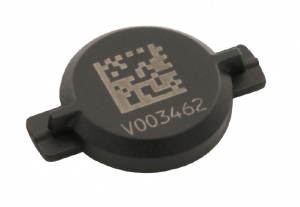
The AWST-OSL-AD 01 eye lens dosimeter we deliver consist of a numbered dosimeter cover made of black plastic and an BeO detector of the type "ezClip". The dosimeter can be assigned to a person via the printed dosimeter ID. The dosimeter is waterproof and can be disinfected.

The principle of Optically Stimulated Luminescence (OSL) is similar to the principle of Thermally Stimulated Luminescence (TL). Energy in the form of ionizing radiation hits the detector made of BeO and is stored by lifting electrons to higher energy levels. During this process, electrons are trapped in so-called electrical traps until excitation by light occurs again and the electrons fall back to the lower energy base level. This causes the detector to release the stored energy in the form of light, and it is excited to glow. The light output measured with photomultipliers is then a measure of the dose.
Unlike Thermally Stimulated Luminescence, Optically Stimulated Luminescence is not excited with heat, but with light.
The eye lens dosimeter is worn on the head, as close as possible to the eye facing the radiation source (e.g. scattered radiation from the patient) and ideally behind an existing shield (radiation protection glasses).

Zur Befestigung des Augenlinsendosimeters wird dieses mittels Steckschlüssel in die jeweilige Halterung eingesetzt. Wir bieten unterschiedliche Halterungsmöglichkeiten an, welche im Folgenden beschrieben werden.

The dosimeter can be clicked into the headband adapter using a socket wrench and worn on a headband on the head. We offer the headband adapters in three different colors (blue, orange, turquoise).

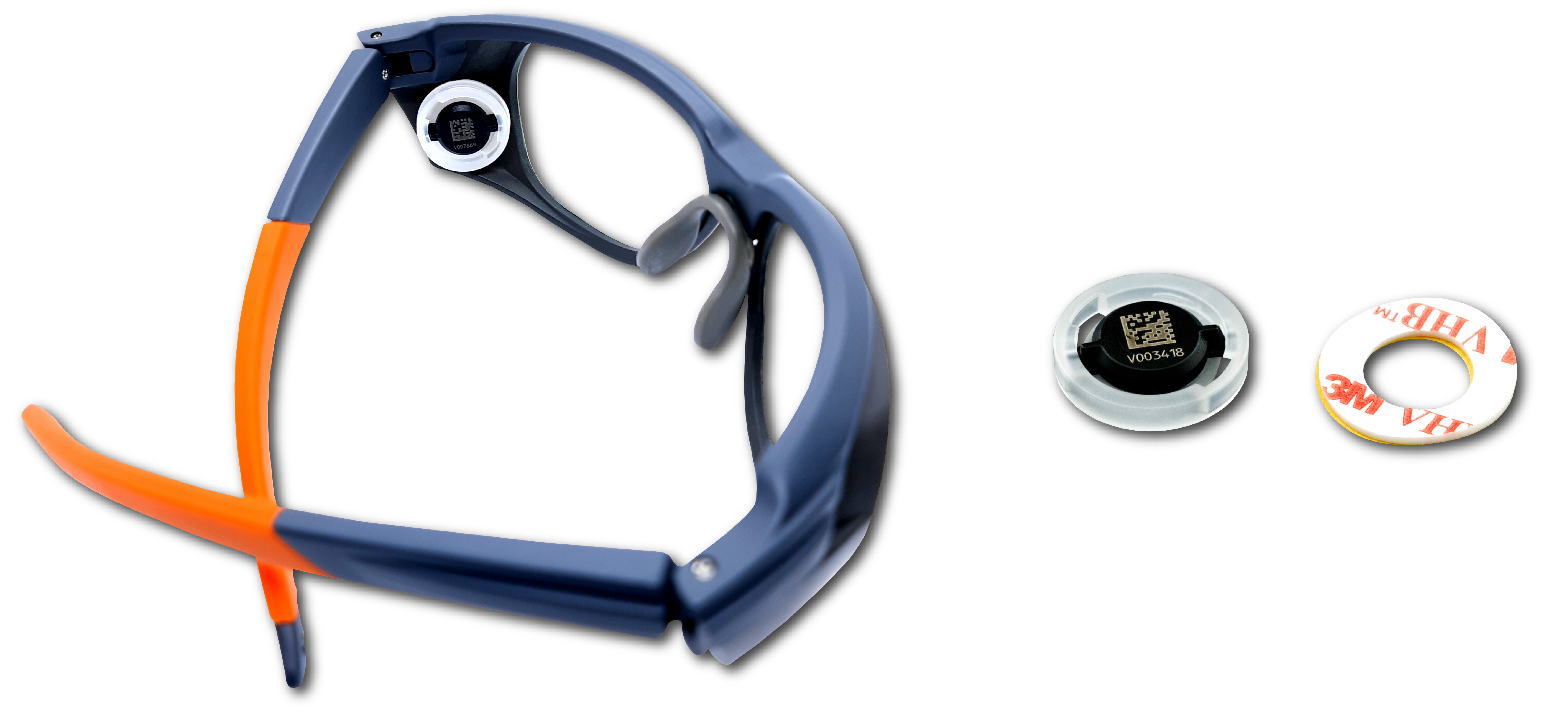
If you already have radiation protection glasses, the dosimeters can also be attached to the inside of your radiation protection glasses using adhesive adapters, depending on the type of glasses.
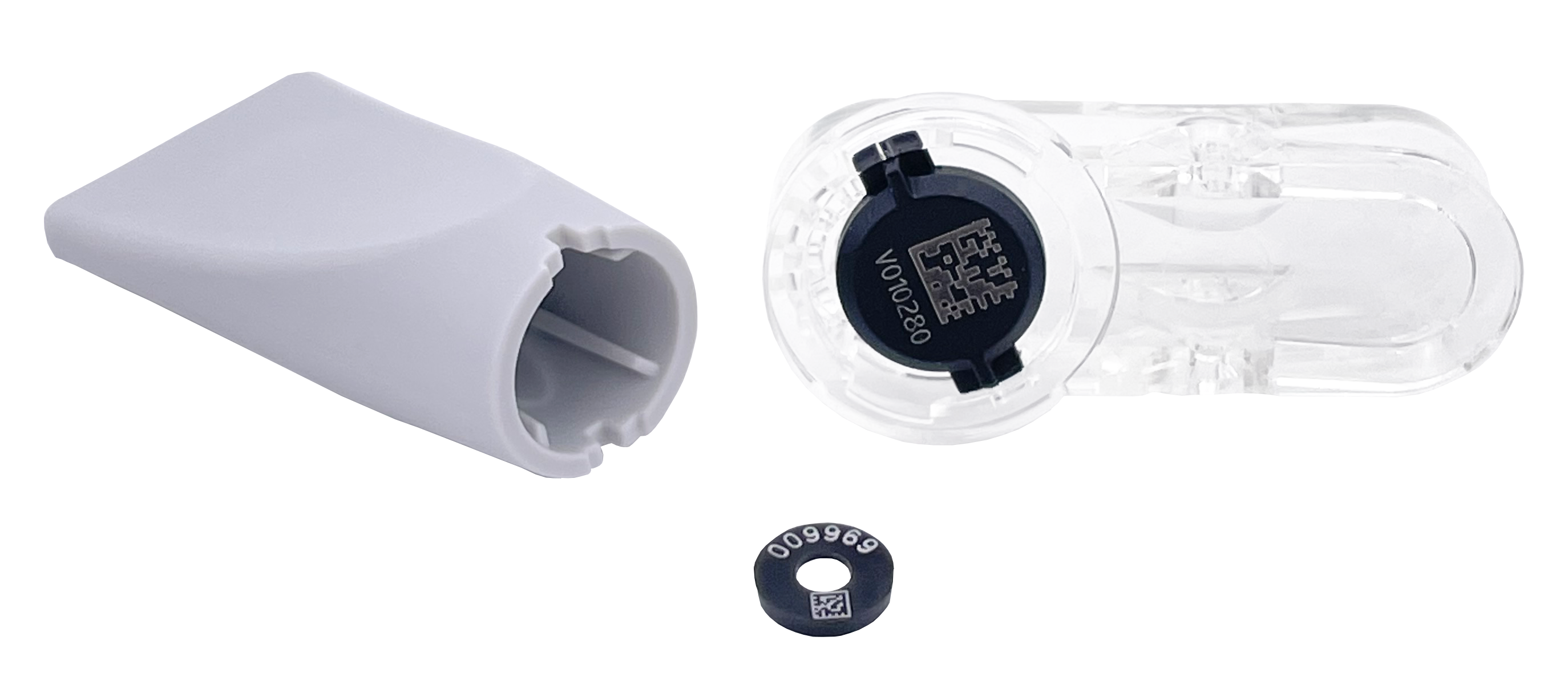
If you already have radiation protection glasses, the dosimeters can also be attached to one of the glasses temples with a clip, depending on the type of glasses.
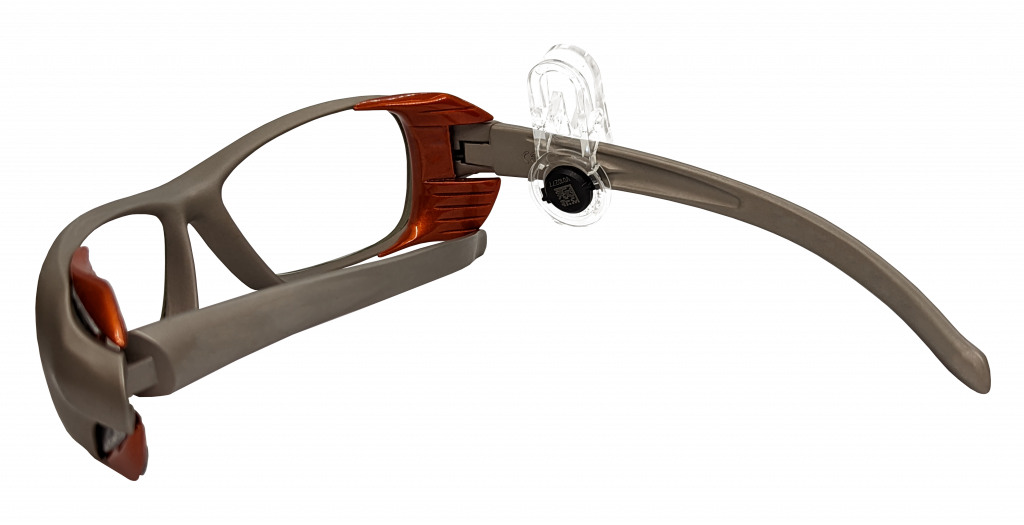

Die Strahlenschutzbrille BR330 der Firma MAVIG wurde in Zusammenarbeit der Mirion Medical GmbH und der Dosilab AG entwickelt und verfügt über eine integrierte Dosimeterhalterung. Diese ermöglicht – je nach Ausführung – das Dosimeter links, rechts oder beidseitig direkt in der Brille anzubringen.
For more information on the BR330 radiation protection glasses, please refer to the MAVIG product flyer.
If you have any questions about deployment or current pricing, our customer service team will be happy to help.
The dosimeter may only be used in pure photon fields or - in the case of beta fields - worn behind radiation protection glasses.
The dosimeter is to be aligned with the anticipated radiation in such a way that it optimally strikes the dosimeter probe perpendicularly from the front or from behind.
The dosimeter is suitable for use at an ambient temperature of -10°C to +40°C and a relative humidity of 10% to 90%. It should not be exposed to direct sunlight above 1000 W/m².
| Type of radiation | measuring range |
Photon energy |
| Photon radiation | 0.1 mSv to 1 Sv |
16 kev to 7 MeV |
Energy and angular response
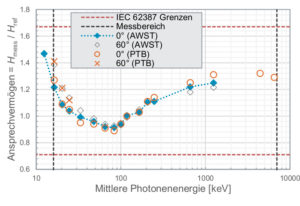
Unfortunately, all previous national and international studies on this topic show that there is no clear assignment of the level of lens exposure to a specific activity. Especially in radiological applications, local radiation protection, the use of personal protective equipment (PPE)*, the design of the equipment used, the professional experience of the physician and other individual parameters determine the level of eye exposure during a procedure. In general, however, it can be stated that if the PPE is used correctly (radiation protection glasses, etc.), exceeding the new limit for eye lens dose should not occur. The results from the studies on the affected workplaces and activities can be summarized as follows:
Nuclear Technology
So far, no exceedances of the eye lens limit value are to be expected here. The eye lens dose can be controlled in almost all areas of activity with the normal personal dosimeters. Beta radiation is effectively shielded from the eyes by the protective lenses of the protective equipment.
Nuclear Medicine
Here, exposures to gamma radiation (e.g. 99mTc), high-energy beta emitters (e.g. 90Y) and positron emitters (e.g. 68Ga, 18F) are possible. Low-energy beta emitters can be effectively shielded with existing laboratory safety glasses, while high-energy beta emitters and photon emitters such as 99mTc can be shielded with lead glasses. High-energy gamma radiation, even in the range of PET (511 keV), cannot be shielded with protective eyewear. However, none of the studies published to date have been able to measure or extrapolate annual doses that are above or near the new annual limit.
Interventional radiology
In interventional radiology, exceedances of the new annual limit of 20mSv/a may occur in all procedures used. Although most activities are well below the limit, measured exposures for the same procedure often differ by a factor of 100 or more, depending on individual factors (especially the radiation protection equipment used - PPE or fixed). For this reason, workplace measurement or at least intermittent monitoring of personnel is recommended and required.
The following individual applications have been shown to be particularly dose-intensive in some cases: embolizations, PTA/PTCA, TIPS, ERCP, RFA, etc.
Cardiology
Here the situation is analogous to exposures in interventional radiology. Individual workplace measurement or temporary personal monitoring is recommended for dose estimation and risk assessment (e.g. PM/ICD).
Surgery
There are no valid data here to date, but temporary measurements should also be performed here, especially in trauma surgery, to assess the risk.
Veterinary Medicine
There is not much data here yet, but initial studies show evidence of problems similar to those in human radiology.
Industry/Research
Here, there is no evidence so far that major exposures or exceedances of the eye lens dose limit can occur.
*Personal protective equipment
The wearing of PPE, especially radiation protection glasses, has the greatest influence on the reduction of the eye lens dose. It is shown that a Pb equivalent of 0.5 mm of the protective glasses brings the best possible protection, an increase does not bring an improved protective effect. The size of the shielded face area, especially the temples, is essential.
In the following publications you can find further information about our eye lens dosimeter:
Hoedlmoser, H., et al., 2019. New Eye Lens Dosemeters for Integration in Radiation Protection Glasses, Radiat. Meas. 125, 106-115. https://doi.org/10.1016/j.radmeas.2019.05.002
Bandalo, V., et. al., 2020. Performance of the BeOSL eye lens dosemeter with radiation protection glasses, Rad. Prot. Dosimetry 131. https://doi.org/10.1016/j.radmeas.2019.106235
Hoedlmoser, H., et. al., 2020. Individual Monitoring with BeOSL Dosemeters: New Dosemeters for Extremity and Area Dosimetry, Rad. Meas., https://doi.org/10.1016/j.radmeas.2020.106258
Strobel, I., et. al., 2021. Eye lens dosimetry with BeOSL Hp(3) dosemeters in interventional angiography and neuroradiology, https://authors.elsevier.com/a/1cqiD4p3dOJNcQ




